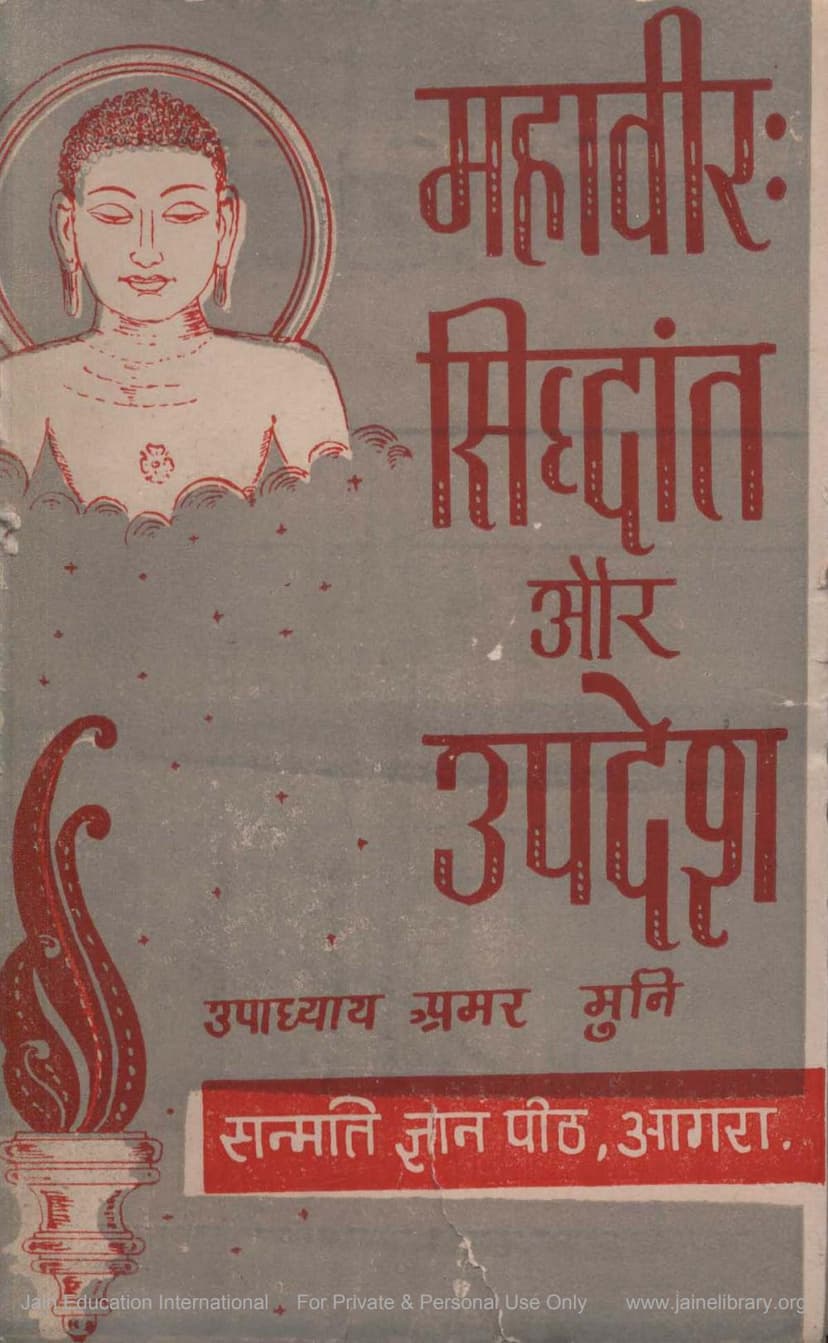Mahavira Siddhanta Aur Updesh
Added to library: September 2, 2025

Summary
This is a comprehensive summary of the Jain text "Mahavira Siddhanta aur Updesh" by Amarmuni, based on the provided catalog link and page content:
Book Title: Mahavira Siddhanta aur Updesh (Mahavira: Principles and Teachings) Author: Upadhyay Amarmuni Publisher: Sanmati Gyan Pith, Agra Catalog Link: https://jainqq.org/explore/001422/1
Overall Theme: The book provides an in-depth exploration of the life, principles, and teachings of Lord Mahavira, the 24th Tirthankara of Jainism. It aims to present a holistic understanding of Mahavira's mission and its impact on Indian society and religion. The author emphasizes that the book is based on both scriptural knowledge and personal experience.
Structure of the Book: The book is divided into three main parts:
-
Mahavir Ki Jeevan-Rekhaen (Mahavira's Life-Lines): This section chronicles the life of Mahavira, focusing on his journey from his birth to his enlightenment and subsequent spiritual activities. It is further broken down into:
- Grihasth Jeevan (Householder Life): This covers Mahavira's childhood, youth, and his life as a prince and householder until his renunciation. It highlights his inherent qualities like bravery and intelligence, his marriage, and his eventual decision to leave worldly life.
- Sadhak Jeevan (Ascetic Life): This part details his arduous spiritual practices for twelve years, enduring immense hardships, insults, and physical suffering with unwavering equanimity and compassion. It showcases his self-reliance and his dedication to attaining Kevala Jnana (omniscience).
- Tirthankar Jeevan (Tirthankara Life): This section describes his life after attaining Kevala Jnana, his extensive preaching, the establishment of the four-fold Jain community (monks, nuns, laymen, laywomen), and his role in ushering in an era of spiritual and social reform.
-
Mahavir Ke Siddhanta (Mahavira's Principles): This part delves into the core philosophical principles propagated by Mahavira, which challenged the prevailing societal and religious norms of his time. Key principles discussed include:
- Aparigraha (Non-possession/Non-attachment): Mahavira identified possession and accumulation as the root cause of suffering. He advocated for detachment from material wealth and worldly possessions, emphasizing that true happiness lies in controlling desires and greed.
- Ahimsa (Non-violence): Ahimsa is presented as the foremost principle of Jainism and a path to universal peace. It encompasses not only physical non-violence but also mental and verbal non-violence. The book highlights Mahavira's efforts to eradicate the prevalent violence in religious sacrifices and societal practices.
- Anekanta (Multi-sidedness/Manysidedness): This principle emphasizes that reality is complex and can be viewed from multiple perspectives. It promotes tolerance and understanding by acknowledging the partial truth in different viewpoints. The book uses examples like the blind men and the elephant to illustrate this concept.
- Samnvaya (Coordination/Synthesis): Mahavira's teachings are presented as a synthesis of various philosophical viewpoints prevalent at the time (Kalavada, Svabhavavada, Karmavada, Purusharthavada, Niyativada). He showed how these seemingly conflicting ideas could be integrated to form a more complete understanding of reality.
- Karmavada (Doctrine of Karma): The book elaborates on the Jain concept of karma, emphasizing that actions (karma) are the primary cause of an individual's experiences of happiness and suffering, rather than divine intervention. It discusses the nature of karma, its binding effects, and the path to liberation from karmic bondage.
-
Mahavir Ke Updesh (Mahavira's Teachings): This final section is a collection of concise, aphoristic teachings of Mahavira on various spiritual and ethical topics. These are presented in a question-and-answer or statement format with explanations. Key themes covered in this section include:
- Atma (Soul): The nature of the soul, its self-reliance, its role as both friend and enemy, and its eternal existence.
- Karmavada (Karma): Reinforcing the principles of karma, emphasizing that one reaps what one sows, and that liberation is achieved through self-effort and the destruction of karma.
- Ahimsa (Non-violence): Further elaborating on the principle of non-violence, highlighting its compassionate aspect and its universality towards all living beings.
- Satya (Truth): The importance of speaking the truth, especially when it is beneficial, and the dangers of untruth.
- Asteya (Non-stealing): The principle of not taking what is not freely given.
- Brahmacharya (Celibacy/Chastity): The significance of controlling desires and practicing chastity for spiritual progress.
- Aparigraha (Non-possession): Reinforcing the idea of detachment and the futility of excessive accumulation.
- Vairagya (Renunciation/Detachment): The transient nature of life and the importance of detachment from worldly pleasures.
- Samata (Equanimity): The state of equanimity in pleasure and pain, praise and blame, honor and dishonor, which leads to liberation.
- Moksha (Liberation): The ultimate goal of spiritual practice, achieved through right faith, right knowledge, and right conduct, leading to the cessation of all karmic bondage and the attainment of eternal bliss.
Key Aspects Highlighted:
- Social Reform: The book emphasizes Mahavira's role in dismantling the caste system, challenging religious rituals based on violence, and uplifting the status of women and marginalized communities.
- Ethical Foundation: It underscores Mahavira's teachings as the bedrock of ethics and morality, guiding individuals towards spiritual growth and societal harmony.
- Holistic Approach: The author aims to present Mahavira not just as a religious leader but as a revolutionary thinker and social reformer whose teachings are relevant for all times.
- Emphasis on Self-Reliance: Mahavira's teachings stress individual responsibility and self-effort in achieving spiritual liberation, rather than relying on external powers or rituals.
- Tolerance and Understanding: Anekanta and Syadvada are presented as tools for fostering interfaith dialogue and resolving conflicts by acknowledging the validity of multiple perspectives.
- Timeless Relevance: The book posits that Mahavira's principles and teachings offer solutions to contemporary societal and spiritual challenges.
In essence, "Mahavira Siddhanta aur Updesh" is a profound and accessible exposition of the life and philosophy of Lord Mahavira, designed to inspire readers to understand and incorporate his timeless teachings into their lives for personal and societal well-being.